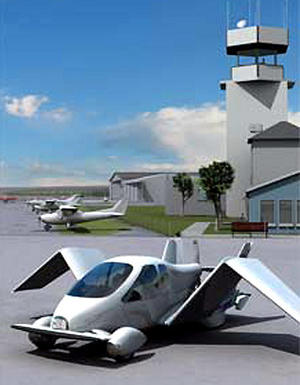Flying carsFAA brings flying car's day closer
There is an inherent problem in designing a flying car: how to build a safe enough car that can still be light enough to compete with the other aircraft in its class; the FAA has given permission to Terrafugia, a flying car pioneer, to add an extra 110 pounds to the Light Sport Aircraft (LSA) limit of 1,320 pounds maximum takeoff weight; the added weight will allow the company to add some automotive safety features such as airbags, crumple zones, and a safety cage, and still qualify as an LSA; the airplane will cruise at a speed of 115 miles per hour and a range of more than 450 miles; on the road, the two place, front wheel drive vehicle achieves a respectable 30 miles per gallon

The Terrafugia preparing for flight // Source: ployer.com
Terrafugia, the company developing the Transition Roadable Aircraft (aka the Flying Car — see “World’s first flying car debuts,” 18 March 2009 HSNW). has been given permission to add some extra pounds to its futuristic product — but this additional weight is likely to contribute to the company’s health. The company has been working hard to overcome the persistent issue of how to build a safe enough car that can still be light enough to compete with the other aircraft in its class. The ambitious design still came in too heavy to qualify as a Light Sport Aircraft (LSA).
Jason Paur writes that the Federal Aviation Administration (FAA) provided a little help to the company by issuing a maximum takeoff weight exemption specifically for the new design. Now Terrafugia can add some automotive safety features such as airbags, crumple zones and a safety cage, and still qualify as a Light Sport Aircraft. The LSA designation is important because it opens the market up to a wider swath of potential customers thanks the simplified requirements needed to receive an LSA pilot’s license.
Terrafugia says the exemption will allow them to be in compliance with the Federal Motor Vehicle Safety Standards, something most of its LSA competitors do not have to worry about. The FAA has granted the company an extra 110 pounds to the LSA limit of 1,320 pounds maximum takeoff weight. Terrafugia says this will allow the extra safety equipment and a still allow the airplane to compete with other LSA aircraft in terms of range and the amount of payload it can carry.
The company successfully completed flight and drive testing of the proof of concept version of its roadable aircraft last year (“Flying car’s proof-of-concept testing now complete,” 6 June 2009 HSNW). The innovative design has foldable wings that allow the owner to drive to the airport, and in less than a minute, convert the car into an airplane. Flying cars are nothing new, but the Transition is easily the most practical version of the idea so far. The company claims the airplane will cruise at a speed of 115 miles per hour and a range of more than 450 miles. On the road, the two place, front wheel drive vehicle achieves a respectable 30 miles per gallon.
Paur quotes Terrafugia to say it will unveil the design of the production version of the Transition in Oshkosh in late July (EAA Airventure, 26 July-1 August). It still hopes to deliver the first customer versions in late 2011.
